Czech stage and film actress Lyda Salmonova (1889–1968) was married to German actor Paul Wegener and appeared with him in silent horror classics like Der Student von Prag/The Student of Prague (1913) and Der Golem (1915 and 1920).
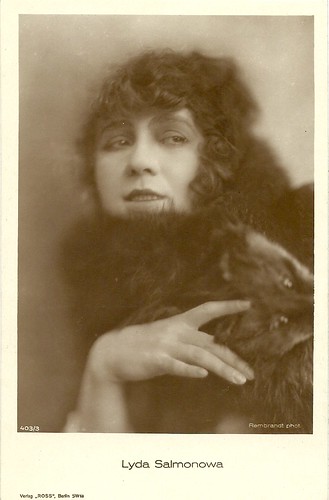
German postcard by Ross Verlag, no. 403/3, 1919-1924. Photo: Rembrandt phot. Collection: Didier Hanson.
Lyda Salmonova (in Germany written as Salmonowa) was born in Prague, Austria-Hungary (now Czech Republic) in 1889. As a girl she took dance classes.
In 1909, she moved to Berlin where she studied acting at the school of the Deutschen Theater. Soon manager-director Max Reinhardt offered her a role. She played a supporting part in the pantomime Sumurun and also played in Der Totentanz by August Strindberg.
One of her first parts in the cinema was the flower girl Lyduschka in the German silent horror film Der Student von Prag/The Student of Prague (Stellan Rye, Paul Wegener, 1913) generally deemed to be the first independent film in history.
Balduin, a poor student (Paul Wegener) rescues a beautiful countess (Grete Berger) and soon becomes obsessed with her. A sorcerer makes a deal with the young man to give him fabulous wealth and anything he wants, if he will sign his name to a contract. The student hurriedly signs the contract, but doesn't know what he's in for.
The film was remade in 1926, under the same title Der Student von Prag/The Student of Prague. Other remakes were produced in 1935 and 2004.
Salmonova and Wegener married in 1913 and would costar in 15 films.
In 1915, she appeared with Wegener in the silent horror film Der Golem/The Monster of Fate, written and directed by Paul Wegenerand Henrik Galeen.
The film is inspired by ancient Jewish legend about the golem, a clay statue brought to life by Rabbi Loew in 16th century Prague to save the Jews from the on-going brutal persecution by the city's rulers.
Der Golem is the first of a trilogy by Wegener, followed by the short comedy Der Golem und die Tänzerin/The Golem and the Dancing Girl (Paul Wegener, Rochus Gliese, 1917) and Der Golem, wie er in die Welt kam/The Golem: How He Came into the World (Carl Boese, Paul Wegener, 1920). In all three films Salmonova played the female lead.
She probably was also in the cast of the horror film Der Bucklige und die Tänzerin/The Hunchback and the Dancer (1920) directed by F. W. Murnau, but the film is considered to be lost.
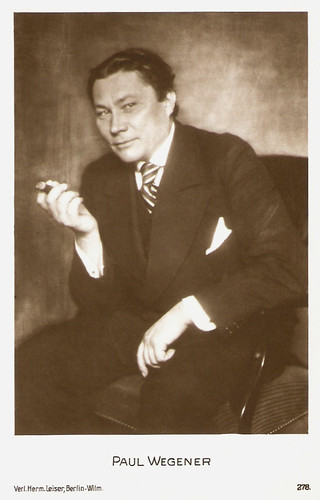
Paul Wegener. German postcard by Verlag Hermann Leiser, Berlin-Wilh., no. 278.
During the early 1920s, Lyda Salmonova appeared in silent films like the adventure film Brennendes Land/Burning Country (Heinz Herald, 1921) starring Marie Wismar, Ernst Deutsch and Kurt Vespermann. She also played a supporting part in the drama Irrende Seelen/Wandering Souls (Carl Froelich, 1921) starring Asta Nielsen, and based on the novel The Idiot by Fyodor Dostoyevsky.
She also appeared in the historical epic Das Weib des Pharao/The Loves of Pharaoh (Ernst Lubitsch, 1922) starring Emil Jannings. A complete version of the film had been considered lost for years, but in 2011 a digitally restored and reconstructed version premièred including the original music by composer Eduard Künneke that had been commissioned for the film by Lubitsch. The Loves of Pharaoh was Lubitsch last German feature before he migrated to Hollywood in 1923.
Salmonova also had a part in the silent historic film Lucrezia Borgia/Lucretia Borgia (Richard Oswald, 1922) featuring Liane Haid.
Her biggest roles were in the films by her husband Paul Wegener. One of their last collaborations was Herzog Ferrantes Ende/Duke Ferrantes End (Paul Wegener, Rochus Gliese, 1922). Her last film was S.O S. Die Insel der Tränen/S.O.S. The island of tears (Lothar Mendes, 1923), as the wife of Paul Wegener.
In 1923 the two divorced and Lyda Salmonova’s film career stopped. She only performed on stage till the early 1930s. She started to work as an acting teacher. She worked at the Ufa film school in Potsdam-Babelsberg and under the name of Lyda Wegener she started her own theatre school.
During the war years she lived in Berlin and was bombed there several times. After the war, she returned to her birthplace Prague. Lyda Salmonova died in 1968 in Prague. She was 79.
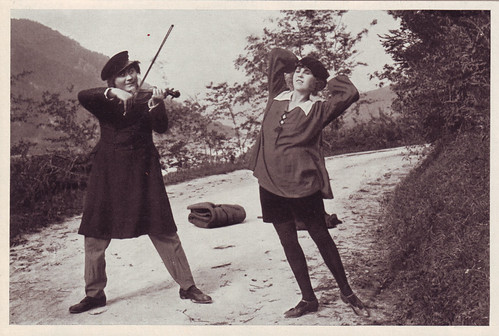
Paul Wegener and Lyda Salmonova. German collectors card by Cigaretten Bilderdienst Altona-Bahrenfeld, no. 133 (Vom Werden deutscher Filmkunst. Der Stümme Film). Collection: Manuel Palomino Arjona.
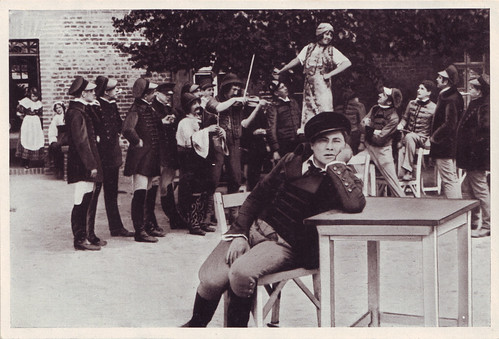
Paul Wegener and Lyda Salmonova. German collectors card by Cigaretten Bilderdienst Altona-Bahrenfeld, no. 9 (Vom Werden deutscher Filmkunst. Der Stümme Film). Collection: Manuel Palomino Arjona.
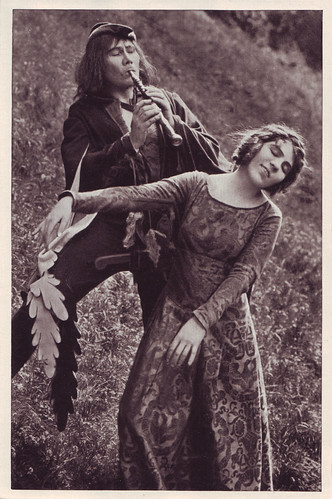
Paul Wegener and Lyda Salmonova. German collectors card by Cigaretten Bilderdienst Altona-Bahrenfeld, no. 86 (Vom Werden deutscher Filmkunst. Der Stümme Film). Collection: Manuel Palomino Arjona.
Sources: Film Zeit.de (German), Wikipedia (German and English), and IMDb.

German postcard by Ross Verlag, no. 403/3, 1919-1924. Photo: Rembrandt phot. Collection: Didier Hanson.
Silent Horror
Lyda Salmonova (in Germany written as Salmonowa) was born in Prague, Austria-Hungary (now Czech Republic) in 1889. As a girl she took dance classes.
In 1909, she moved to Berlin where she studied acting at the school of the Deutschen Theater. Soon manager-director Max Reinhardt offered her a role. She played a supporting part in the pantomime Sumurun and also played in Der Totentanz by August Strindberg.
One of her first parts in the cinema was the flower girl Lyduschka in the German silent horror film Der Student von Prag/The Student of Prague (Stellan Rye, Paul Wegener, 1913) generally deemed to be the first independent film in history.
Balduin, a poor student (Paul Wegener) rescues a beautiful countess (Grete Berger) and soon becomes obsessed with her. A sorcerer makes a deal with the young man to give him fabulous wealth and anything he wants, if he will sign his name to a contract. The student hurriedly signs the contract, but doesn't know what he's in for.
The film was remade in 1926, under the same title Der Student von Prag/The Student of Prague. Other remakes were produced in 1935 and 2004.
Salmonova and Wegener married in 1913 and would costar in 15 films.
In 1915, she appeared with Wegener in the silent horror film Der Golem/The Monster of Fate, written and directed by Paul Wegenerand Henrik Galeen.
The film is inspired by ancient Jewish legend about the golem, a clay statue brought to life by Rabbi Loew in 16th century Prague to save the Jews from the on-going brutal persecution by the city's rulers.
Der Golem is the first of a trilogy by Wegener, followed by the short comedy Der Golem und die Tänzerin/The Golem and the Dancing Girl (Paul Wegener, Rochus Gliese, 1917) and Der Golem, wie er in die Welt kam/The Golem: How He Came into the World (Carl Boese, Paul Wegener, 1920). In all three films Salmonova played the female lead.
She probably was also in the cast of the horror film Der Bucklige und die Tänzerin/The Hunchback and the Dancer (1920) directed by F. W. Murnau, but the film is considered to be lost.

Paul Wegener. German postcard by Verlag Hermann Leiser, Berlin-Wilh., no. 278.
Wandering Souls
During the early 1920s, Lyda Salmonova appeared in silent films like the adventure film Brennendes Land/Burning Country (Heinz Herald, 1921) starring Marie Wismar, Ernst Deutsch and Kurt Vespermann. She also played a supporting part in the drama Irrende Seelen/Wandering Souls (Carl Froelich, 1921) starring Asta Nielsen, and based on the novel The Idiot by Fyodor Dostoyevsky.
She also appeared in the historical epic Das Weib des Pharao/The Loves of Pharaoh (Ernst Lubitsch, 1922) starring Emil Jannings. A complete version of the film had been considered lost for years, but in 2011 a digitally restored and reconstructed version premièred including the original music by composer Eduard Künneke that had been commissioned for the film by Lubitsch. The Loves of Pharaoh was Lubitsch last German feature before he migrated to Hollywood in 1923.
Salmonova also had a part in the silent historic film Lucrezia Borgia/Lucretia Borgia (Richard Oswald, 1922) featuring Liane Haid.
Her biggest roles were in the films by her husband Paul Wegener. One of their last collaborations was Herzog Ferrantes Ende/Duke Ferrantes End (Paul Wegener, Rochus Gliese, 1922). Her last film was S.O S. Die Insel der Tränen/S.O.S. The island of tears (Lothar Mendes, 1923), as the wife of Paul Wegener.
In 1923 the two divorced and Lyda Salmonova’s film career stopped. She only performed on stage till the early 1930s. She started to work as an acting teacher. She worked at the Ufa film school in Potsdam-Babelsberg and under the name of Lyda Wegener she started her own theatre school.
During the war years she lived in Berlin and was bombed there several times. After the war, she returned to her birthplace Prague. Lyda Salmonova died in 1968 in Prague. She was 79.

Paul Wegener and Lyda Salmonova. German collectors card by Cigaretten Bilderdienst Altona-Bahrenfeld, no. 133 (Vom Werden deutscher Filmkunst. Der Stümme Film). Collection: Manuel Palomino Arjona.

Paul Wegener and Lyda Salmonova. German collectors card by Cigaretten Bilderdienst Altona-Bahrenfeld, no. 9 (Vom Werden deutscher Filmkunst. Der Stümme Film). Collection: Manuel Palomino Arjona.

Paul Wegener and Lyda Salmonova. German collectors card by Cigaretten Bilderdienst Altona-Bahrenfeld, no. 86 (Vom Werden deutscher Filmkunst. Der Stümme Film). Collection: Manuel Palomino Arjona.
Sources: Film Zeit.de (German), Wikipedia (German and English), and IMDb.
No comments:
Post a Comment